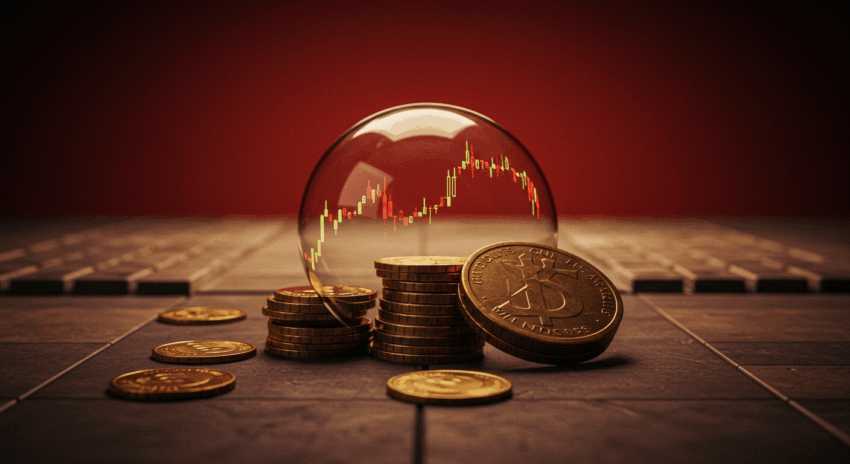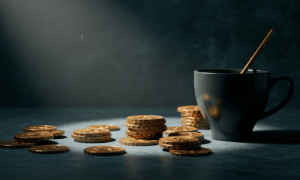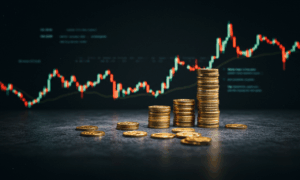What Is an Economic Bubble and How to Know If We’re in One (Warning Signs)
Have you ever watched the price of an asset, whether it’s stocks, real estate, or a new digital currency, skyrocket with seemingly no end in sight? The excitement is palpable, and stories of overnight millionaires dominate the news. This phenomenon, known as an economic bubble, is a recurring theme in financial history. While exhilarating on the way up, the inevitable pop can be devastating for unprepared investors. Understanding what an economic bubble is and recognizing its warning signs is one of the most crucial skills you can develop to protect your financial future.
This article will demystify the concept of financial bubbles. We will explore what causes them, the distinct stages they typically follow, and most importantly, the key indicators that can help you identify if you are in the middle of one. Armed with this knowledge, you can make more informed decisions and navigate turbulent market conditions with greater confidence. Let’s delve into the mechanics of market manias and how to safeguard your portfolio.
Defining an Economic Bubble: When Prices Lose Touch with Reality
At its core, an economic bubble, also known as an asset bubble or speculative bubble, occurs when the price of an asset rises to a level that is significantly higher than its intrinsic or fundamental value. Intrinsic value refers to the worth of an asset based on its underlying financial reality, such as a company’s earnings, a property’s rental income, or a commodity’s industrial use. In a bubble, prices are no longer driven by these fundamentals but by something far more emotional: speculation.
Investors start buying an asset not because they believe it’s worth its current price, but because they believe someone else will buy it from them at an even higher price in the future. This is often called the “greater fool theory.” This speculative frenzy creates a self-reinforcing cycle. As prices rise, more people are drawn in, pushing prices even higher. This continues until confidence shatters, and the bubble bursts, leading to a rapid and often catastrophic price collapse.

The Anatomy of a Bubble: The Five Classic Stages
Financial historians have identified a common pattern that most speculative bubbles follow. Understanding these five stages, as outlined by economist Hyman Minsky, can provide a roadmap for identifying where the market might be in its cycle. While not every bubble is identical, this framework is incredibly useful.
- Displacement: A bubble often begins with a “displacement,” which is a paradigm shift or a new development that captures investors’ imaginations. This could be a groundbreaking technology like the internet, a new financial product, or a period of unusually low interest rates that makes borrowing cheap. This event changes expectations and presents new, exciting profit opportunities.
- Boom: As early investors profit, more people take notice. The asset begins to gain momentum, and prices start to rise. Media coverage increases, attracting mainstream investors who may not fully understand the asset but are drawn in by the promise of quick returns. Access to credit often becomes easier, allowing more money to flow into the asset.
- Euphoria: This is the peak of speculative fever. Caution is thrown to the wind, and prices explode upward. You will hear phrases like “This time is different” to justify the sky-high valuations. The fear of missing out (FOMO) is at its strongest, pulling in even the most skeptical investors. At this stage, valuations become completely detached from reality.
- Profit-Taking: The smart money and institutional investors, sensing the peak, begin to quietly sell their positions and take profits. However, the sheer momentum of public buying can keep prices elevated for a while longer, creating a “plateau” where the market seems to be catching its breath. This is often a precarious stage where the first signs of weakness appear.
- Panic: A trigger event, such as a negative news story or a large player selling off, causes sentiment to shift dramatically. The realization dawns that prices are unsustainable. Everyone rushes to sell at once, but there are few buyers left. Prices plummet, and the bubble bursts. This phase is characterized by fear, forced selling, and significant financial losses.
Key Warning Signs: Are We in a Bubble Right Now?
Identifying a bubble in real-time is notoriously difficult, but there are several red flags that should prompt caution. If you see several of these signs appearing simultaneously in a market, it is time to reassess your risk exposure. Check your investment strategy and ensure it aligns with your long-term goals, not short-term market hype.
- Rapid Price Acceleration: Asset prices are not just rising; they are going parabolic. The charts show an increasingly steep upward curve. This is often a sign that emotion, not valuation, is driving the market.
- Widespread Public Participation and Media Hype: When your taxi driver, barista, and relatives who have never invested before are giving you stock tips, it’s a major warning sign. The media fuels this with constant, breathless coverage of rising prices and success stories.
- Abandonment of Traditional Valuation Metrics: People begin to justify astronomical prices with new, often questionable, metrics. You might hear arguments that traditional measures like price-to-earnings ratios are “outdated” for this “new economy.” This is a classic attempt to rationalize irrational prices.
- “This Time Is Different” Mentality: History is littered with bubbles where participants claimed a new paradigm had rendered old economic rules obsolete. This belief is a powerful psychological trap that allows people to ignore clear signs of overvaluation.
- Extreme Leverage: Investors are borrowing heavily to buy the appreciating asset. Easy credit fuels the bubble by allowing more money to chase the same assets, pushing prices higher. When the bubble bursts, this leverage amplifies losses and can lead to financial ruin.
How to Protect Your Finances from a Market Bubble
You cannot control the market, but you can control your own actions. Protecting your capital requires discipline and a focus on fundamental principles, especially when market sentiment is euphoric. Understanding the broader economy can provide context for market movements.
First and foremost, diversify your portfolio. Do not put all your eggs in one basket, especially not the basket that everyone is talking about. Spreading your investments across different asset classes (stocks, bonds, real estate) and geographic regions can cushion the blow if one sector crashes.
Second, focus on fundamental value. Before you invest, ask yourself: what is this asset truly worth based on its earnings, cash flow, or utility? If you cannot come up with a sensible answer, you may be speculating, not investing. Avoid companies with no profits and no clear path to profitability, even if their stock price is soaring. Stick to your principles and do not get swept up in the mania.
Finally, avoid using excessive leverage and have a clear exit strategy. Borrowing to invest is incredibly risky in a frothy market. A price drop can trigger margin calls and force you to sell at the worst possible time. Define the conditions under which you will sell an investment before you buy it. This removes emotion from the decision-making process when panic sets in.
Conclusion: Navigating the Tides of Market Psychology
Economic bubbles are a product of human psychology, fueled by greed and fear. They have happened countless times throughout history and will undoubtedly happen again. While the allure of getting rich quick is powerful, the risk of catastrophic loss is very real. The key to successful long-term investing is not to perfectly time the market but to remain disciplined and rational when others are not.
By understanding the stages of a bubble, recognizing the warning signs of irrational exuberance, and adhering to sound financial principles like diversification and value investing, you can protect yourself. Keep learning about finance and markets to build your knowledge and confidence. Remember, building wealth is a marathon, not a sprint. Do not let a speculative bubble derail your journey to financial security.
Frequently Asked Questions (FAQ)
Can anyone predict exactly when a bubble will burst?
No, it is nearly impossible to predict the exact timing of a bubble’s collapse. While experts can identify the conditions of a bubble, the specific trigger that causes the panic can be unpredictable. This is why it is far more effective to focus on managing risk in your own portfolio rather than trying to time the market’s peak.
Are all rapidly rising markets a bubble?
Not necessarily. Strong bull markets can be driven by genuine economic growth, innovation, and solid corporate earnings. The key difference is the connection to fundamental value. In a healthy bull market, price increases are supported by underlying improvements. In a bubble, prices become completely detached from those fundamentals and are driven purely by speculation.
What is the difference between a market correction and a bubble bursting?
A market correction is generally defined as a decline of 10% to 20% from a recent peak. Corrections are a normal and healthy part of the market cycle, shaking out excess speculation without causing long-term structural damage. A bubble bursting is a much more severe event, often involving a price collapse of 40%, 50%, or even more. It is accompanied by widespread panic and can lead to a recession and lasting economic damage.



